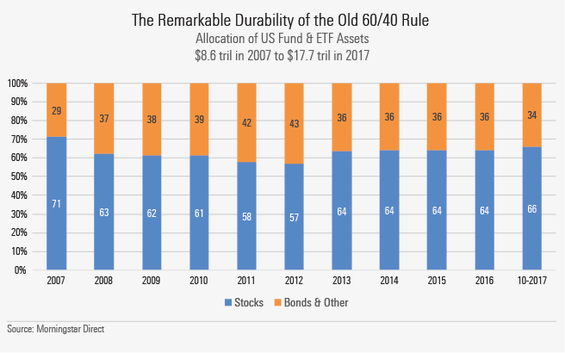As this year draws to a close, we wanted to offer advisers a few trends to look for in 2018. Some concepts may look familiar:
5 investment themes for advisors in 2018
- Investors will continue to rebalance portfolios as equity allocations outgrow their trousers. To the disappointment of pundits everywhere, the overall asset allocation of fund and exchange-traded fund investors hasn’t changed much at all since 2008. What you find is a big dollop of boring—which is to say good, sensible asset allocation. As Morningstar’s Christine Benz recently found, a 60/40 portfolio in 2009, un-rebalanced, is now 83/17. Fortunately, it appears that advisors and investors have wisely rebalanced in aggregate along the way.

- Some investors can’t resist the shiny thing, and now it’s your problem. Advisors have done yeoman’s work over the years to convince clients to ignore the headlines, adopt a sensible but uninteresting portfolio, and not chase the latest hot investment opportunity. But once a decade or so, an investing idea comes around that few of us can resist. This time, it’s bitcoin. My colleague Tom Lauricella says that, for the first time since the global financial crisis started in 2008, greed is back. So it’s not surprising that advisors have been fielding calls from clients in recent weeks along the lines of, “Why didn’t you get me into ‘the’ bitcoin?!” If your clients have a revived taste for speculation and you manage to steer them away from bitcoin (for the moment), you can look forward to a few interesting investment opportunities from IPOs in 2018 that may sate their appetites. PitchBook tracks private companies as they move toward the public markets. And you can access the firm’s research about the IPO plans of companies such as Lyft, Spotify, Airbnb, and BuzzFeed on the PitchBook platform before the road shows and press coverage. My prediction: Next year’s bitcoin will probably be…bitcoin.
- The case for liquid alternatives will get even weaker. Liquid alternatives capture more than their share headlines in the investing press, feature prominently at advisor conferences, and have been the stuff of a thousand lunch invitations from product providers since 2009. But for all the hullabaloo, alternatives today represent only 1.25% of U.S. investors’ dollars in funds and ETFs. What’s more, interest in liquid alts strategies has gone into reverse for the 12 months ending October 31, with outflows of $3.1 billion. For most alts strategies managers, the news is even worse: AQR is dominating the alts world; most of the other 195 providers in the market are gasping for air. It seems a pretty tall order to expect alternatives to take off next year in the face of this trend. Except for AQR and a few specialists, we should expect more funds to shutter in 2018. To access the full body of Morningstar’s research and analytics on liquid alts, consider tapping into the power of Morningstar Office℠ Cloud.
- Investor adoption of ESG funds will struggle to get out of neutral in 2018. Most surveys of advisors suggest that investor interest is growing in investing in accordance with their values. Yet the rate of flows into environmental, social, and governance, or ESG, funds in 2017 have been on par with funds as a whole. ESG is not yet a growth story. Why? First, the cohort that expresses the most interest—millennials—have the least to invest. Second, the most natural place for millennials to begin to invest—their company’s 401(k) plan—is unlikely to offer an ESG option, although a few ESG target-date series have popped up. Finally, there just are not enough good options in the market, especially passive ones, to satisfy investors’ very specific values-based-investing needs. Some of these strategies do exist, but they’re hard to find. (We’re working on it at Morningstar.) Sustainable investing is ready to go mainstream, but it’s going to take a little more time for interest to become reality.
- At least 1 unloved category for 2017 will be unloved in 2018, despite strong results so far in 2017. Each January, my colleagues in manager research publish their list of unloved fund categories. The idea is to buy three funds from categories that experienced large outflows in the recently passed year in the new year. The hypothesis, of course, is that investors tend to flee underperforming categories as just the wrong time, missing their inevitable performance rebounds. Unloved categories of 2017 are European Stock, Large Growth, and Mid-Cap Growth. So how has this strategy worked so far in 2017? Particularly well, yet these categories are still unloved. (Returns are through December 4.)



